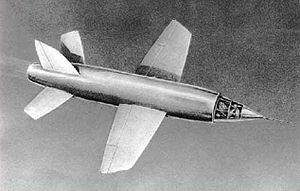Miles M.52
| Miles M.52 | |
|---|---|
 |
|
| Artist's impression of the Miles M.52 | |
| Role | Experimental supersonic aircraft |
| National origin | United Kingdom |
| Manufacturer | Miles Aircraft |
| Designer | Don L. Brown |
| Status | Cancelled |
| Number built | 1 |
The Miles M.52 was a turbojet-powered supersonic research aircraft project designed in the United Kingdom in the mid-1940s. In October 1943, Miles Aircraft was issued with a contract to produce the aircraft in accordance with Air Ministry Specification E.24/43. The programme was highly ambitious for its time, aiming to produce an aircraft and engine capable of unheard-of speeds of at least 1,000 miles per hour (1,600 km/h) during level flight, and involved a very high proportion of cutting-edge aerodynamic research and innovative design work.
Between 1942 and 1945, all work on the project was undertaken with a high level of secrecy. In February 1946, the programme was terminated, seemingly due to budgetary reasons, as well as a disbelief held by some ministry officials on the viability of supersonic aircraft in general. In September 1946, the existence of the M.52 was revealed to the general public, leading to calls for official explanation as to why the project had been terminated and derision of the decision. The Air Ministry controversially decided to revive the design, but as a series of unmanned rocket-powered 30 per cent scale models instead of the original manned full-scale aircraft that had been previously under development. These unmanned scale models were air-launched from a modified de Havilland Mosquito mother ship.
During one successful test flight, Mach 1.38 was achieved by a scale model in normally controllable transonic and supersonic level flight, a unique achievement at that time which validated the aerodynamics of the M.52. At that point, the ministry had cancelled that project and issued a new requirement, which would ultimately result in the English Electric Lightning interceptor aircraft. Work on the afterburning version of the Power Jets W.B.2/700 turbojet was also cancelled and the Power Jets company was incorporated into the National Gas Turbine Establishment. The design and the research gained from the M.52 was shared with the American company Bell Aircraft, who applied it to their own Bell X-1 high speed prototype aircraft, which went on to become the first aircraft to exceed the speed of sound in 1948.
...
Wikipedia
